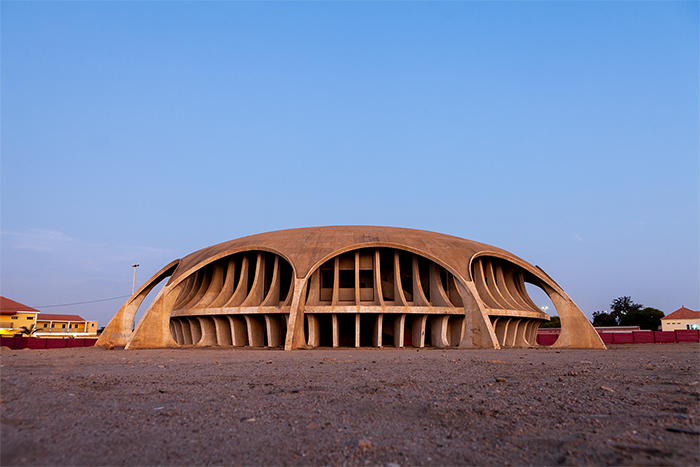FAUP Research Project for the Conservation of Cine-Estúdio Namibe Selected for World Monuments Watch 2025
Award

FAUP Research Project for the Conservation of Cine-Estúdio Namibe Selected for World Monuments Watch 2025 Award
15th January 2025
FAUP's research project, in partnership with Iperforma Angola, for the safeguarding and conservation of Cine-Estúdio Namibe, in Angola, has been selected to be part of the World Monuments Watch 2025, promoted by the World Monuments Fund, the leading independent organisation dedicated to safeguarding the world's most precious sites.
The choice of Cine-Estúdio Namibe to join the World Monuments Watch 2025 list of 25 historic sites of global significance, out of hundreds of applications, reflects its importance to Angola as a significant landmark of its cultural heritage.
With this selection and over the next two years, the project will benefit from a range of support and resources for the research work around Cine-Estúdio Namibe, seeking to establish a close relationship with the Government of the Republic of Angola.
The research will be carried out with the involvement and consultation of local communities and partners, who are crucial to the success of the initiative, and by a multidisciplinary team made up of national and international specialists with vast experience in the field of architecture and heritage conservation.
The project is part of FAUP's Centre for Architecture and Urbanism Studies (CEAU) and is one of the lines of action of the UNESCO Chair ‘Heritage, Cities and Landscapes. Sustainable Management, Conservation, Planning and Design', awarded to the University of Porto through the FAUP.
The team that prepared the application is made up of Teresa Cunha Ferreira (FAUP/CEAU, UNESCO Chair), Luis Urbano (FAUP/CEAU), Pedro Murilo Freitas (FAUP/CEAU, UNESCO Chair), Ana Tostões (Técnico Lisboa, FAUP/CEAU) and Rui Fernandes Póvoas (FAUP/CEAU, UNESCO Chair), as well as consultants Paulo B. Lourenço (UMinho/DEC) and Maria Manuel de Oliveira (UMinho/EAAD). The application was drawn up in partnership with Iperforma Angola (Daniel Quintã, Margarida Quintã and Afonso Quintã) and Susana Matos (Universidade Lusíada de Angola) acted as project manager on the ground. Over the next two years, partnerships and collaborations will be established with other organisations and local representatives.
According to the project's coordinator, Teresa Cunha Ferreira, ‘this research aims, through dedicated resources and multidisciplinary teams, to boost the use and dissemination of an emblematic building for local communities, along with its long-term conservation and maintenance. At the same time, it will raise international awareness of the need to safeguard Angola's modern heritage, in some cases at risk, and pass it on to future generations.’
Cine-Estúdio Namibe: An emblematic monument of Tropical Modernism
The Cine-Estúdio Namibe is an important example of tropical modern architecture, designed by the Portuguese architect José Botelho Pereira in Namibe, Angola, in 1973. Commissioned by Sociedade Cine Moçâmedes, S.A.R.L., it was previously owned by Gaspar Gonçalo Madeira, António Pedro Bauleth and Eurico dos Santos Martins.
The city of Moçâmedes, in the province of Namibe, prospered in the 19th century due to its strategic location near the port and its fishing activity, and throughout the 20th century it established itself as an important cultural centre in the south of the country. The Cine-Estúdio Namibe, along with other cultural facilities built in the 1960s and 1970s, reflects the urban transformation of the city, which was part of the expansion zone planned during the last years of the Portuguese colonial period.
The building was never fully completed as its construction, which began in 1974, was interrupted the following year as a result of the political instability that followed the proclamation of Angola's independence (1975).
Its unique circular shape, which has earned it the popular nickname of ‘spaceship’, has become an emblematic landmark in the city of Moçâmedes and was recently classified as a national heritage site by the Angolan Ministry of Culture, Tourism and Environment.
Although it remained in a state of neglect for more than fifty years, the modernist concrete structure of the Cine-Estúdio Namibe, now owned by the Government of Namibe, remains largely intact and is today considered a valuable representation of ‘Tropical Modernism’ in Angola.
About World Monuments Watch
World Monuments Fund é a principal organização independente dedicada à salvaguarda dos locais mais preciosos do mundo, enriquecendo vidas e promovendo a compreensão mútua. Há mais de 55 anos, trabalhando em mais de 700 locais em 112 países, os seus especialistas altamente qualificados aplicam técnicas comprovadas e eficazes para a preservação de importantes sítios arquitectónicos e culturais em todo o mundo. Através do World Monuments Watch — um programa bienal baseado em candidaturas — a WMF utiliza a conservação do património cultural para capacitar comunidades e melhorar o bem-estar humano. Em parceria com comunidades locais, financiadores e governos, a WMF procura inspirar um compromisso duradouro com a preservação para as gerações futuras. Com sede em Nova Iorque, a organização possui escritórios e filiais em várias partes do mundo.
More information